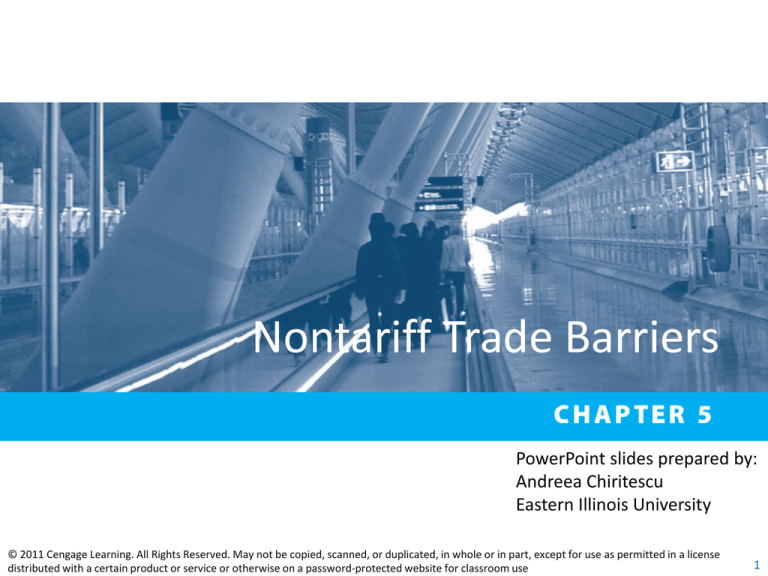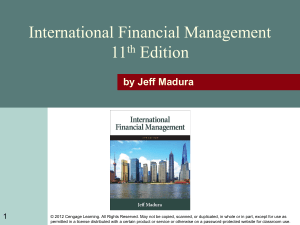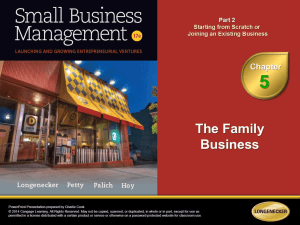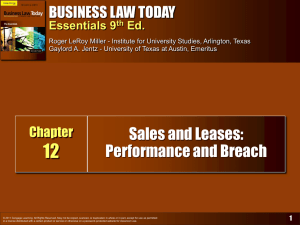
Nontariff Trade Barriers
PowerPoint slides prepared by:
Andreea Chiritescu
Eastern Illinois University
© 2011 Cengage Learning. All Rights Reserved. May not be copied, scanned, or duplicated, in whole or in part, except for use as permitted in a license
distributed with a certain product or service or otherwise on a password‐protected website for classroom use
1
Import Quota
• Import quota
• Physical restriction on the quantity of goods
that can be imported during a specific time
period
• Require an import license
• Specifies the total volume of imports allowed
• On manufactured goods
• Outlawed by the World Trade Organization
© 2011 Cengage Learning. All Rights Reserved. May not be copied, scanned, or duplicated, in whole or in part, except for use as permitted in a license
distributed with a certain product or service or otherwise on a password‐protected website for classroom use
2
TABLE 5.1
Examples of U.S. import quotas*
© 2011 Cengage Learning. All Rights Reserved. May not be copied, scanned, or duplicated, in whole or in part, except for use as permitted in a license
distributed with a certain product or service or otherwise on a password‐protected website for classroom use
3
Import Quota
• Global quota
• Permits a specified number of goods to be
imported each year
• Does not specify from where the product is shipped
or who is permitted to import
• Plagued by accusations of favoritism
• Selective quota
• Import quota allocated to specific countries
• May lead to a domestic monopoly of
production and higher prices
© 2011 Cengage Learning. All Rights Reserved. May not be copied, scanned, or duplicated, in whole or in part, except for use as permitted in a license
distributed with a certain product or service or otherwise on a password‐protected website for classroom use
4
Import Quota
• Effects of import quota on economy’s welfare
• Price increase
• Decrease in consumer surplus
• Redistributive effect
• Deadweight loss
• Protective effect
• Consumption effect
• Revenue effect
• Windfall profit
• Quota rent
© 2011 Cengage Learning. All Rights Reserved. May not be copied, scanned, or duplicated, in whole or in part, except for use as permitted in a license
distributed with a certain product or service or otherwise on a password‐protected website for classroom use
5
FIGURE 5.1
Import quota: trade and welfare effects
By restricting available supplies of an imported product, a quota leads to higher import prices. This
price umbrella allows domestic producers of the import-competing good to raise prices. The result is
a decrease in the consumer surplus. Of this amount, the welfare loss to the importing nation
consists of the protective effect, the consumption effect, and that portion of the revenue effect that
is captured by the foreign exporter.
© 2011 Cengage Learning. All Rights Reserved. May not be copied, scanned, or duplicated, in whole or in part, except for use as permitted in a license
distributed with a certain product or service or otherwise on a password‐protected website for classroom use
6
Import Quota
• Allocating quota licenses
• Historical share of import market
• Oil and dairy products
• Discriminates against importers seeking to import
goods for the first time
• Pro rata basis
• U.S. importers receive a fraction of their demand
• = Ratio of the import quota to the total quantity
demanded collectively by U.S. importers
© 2011 Cengage Learning. All Rights Reserved. May not be copied, scanned, or duplicated, in whole or in part, except for use as permitted in a license
distributed with a certain product or service or otherwise on a password‐protected website for classroom use
7
Import Quota
• Allocating quota licenses
• Auctioning of import licenses
• To the highest bidder in a competitive market
• Government - capture the windfall profits
• Considered by U.S.
© 2011 Cengage Learning. All Rights Reserved. May not be copied, scanned, or duplicated, in whole or in part, except for use as permitted in a license
distributed with a certain product or service or otherwise on a password‐protected website for classroom use
8
Quotas Versus Tariffs
• During periods of growing demand
• An import quota restricts the volume of
imports
• By a greater amount than does an equivalent
import tariff
• Quota
• More restrictive than a tariff
• Suppresses competition
© 2011 Cengage Learning. All Rights Reserved. May not be copied, scanned, or duplicated, in whole or in part, except for use as permitted in a license
distributed with a certain product or service or otherwise on a password‐protected website for classroom use
9
FIGURE 5.2
Trade effects of tariffs versus quotas
In a growing market, an import tariff is a less restrictive trade barrier than an equivalent import quota.
With an import tariff, the adjustment that occurs in response to an increase in domestic demand is an
increase in the amount of the product that is imported. With an import quota, an increase in demand
induces an increase in product price. The price increase leads to a rise in production and a fall in
consumption of the import-competing good, while the level of imports remains constant.
© 2011 Cengage Learning. All Rights Reserved. May not be copied, scanned, or duplicated, in whole or in part, except for use as permitted in a license
distributed with a certain product or service or otherwise on a password‐protected website for classroom use
10
Tariff-Rate Quota: A Two-Tier Tariff
• Tariff-rate quota
• Two-tier tariff
• A quota that defines the maximum volume of
imports
• And charges the within-quota tariff
• Any imports above this level face a higher tariff
rate
• Over-quota tariff
© 2011 Cengage Learning. All Rights Reserved. May not be copied, scanned, or duplicated, in whole or in part, except for use as permitted in a license
distributed with a certain product or service or otherwise on a password‐protected website for classroom use
11
TABLE 5.2
Examples of U.S. tariff-rate quotas
Product
Within-Quota
Tariff Rate
Import-Quota
Threshold
Over-Quota
Tariff Rate
Peanuts
Beef
Milk
Blue cheese
Cotton
9.35 cents/kg
4.4 cents/kg
3.2 cents/L
10 cents/kg
4.4 cents/kg
30,393 tons
634,621 tons
5.7 million L
2.6 million kg
2.1 million kg
187.9 percent ad valorem
31.1 percent ad valorem
88.5 cents/L
$2.60/kg
36 cents/kg
© 2011 Cengage Learning. All Rights Reserved. May not be copied, scanned, or duplicated, in whole or in part, except for use as permitted in a license
distributed with a certain product or service or otherwise on a password‐protected website for classroom use
12
Tariff-Rate Quota: A Two-Tier Tariff
• Administration of tariff-rate quotas
• License on demand allocation
• If demand exceeds the quota, the import volume
requested is reduced proportionally among all
applicants
• Historical market share
• Auctions
© 2011 Cengage Learning. All Rights Reserved. May not be copied, scanned, or duplicated, in whole or in part, except for use as permitted in a license
distributed with a certain product or service or otherwise on a password‐protected website for classroom use
13
Tariff-Rate Quota: A Two-Tier Tariff
• U.S. sugar industry
• Government subsidies
• Price support
• Tariff-rate quota
• Sugar tariff-rate quota
• Raw cane sugar
• Allocated on a country-by-country basis among 41
countries
• Refined sugar
• Allocated in a global first-come, first-serve basis
© 2011 Cengage Learning. All Rights Reserved. May not be copied, scanned, or duplicated, in whole or in part, except for use as permitted in a license
distributed with a certain product or service or otherwise on a password‐protected website for classroom use
14
Tariff-Rate Quota: A Two-Tier Tariff
• Sugar tariff-rate quota
• Restrict the supply of foreign sugar from
entering U.S.
• Higher domestic sugar price
• 2006, U.S. price = 20.94 cents per pound
• World price = 10.42 cents per pound
• American consumers - spend extra $2 billion a year
on sugar
© 2011 Cengage Learning. All Rights Reserved. May not be copied, scanned, or duplicated, in whole or in part, except for use as permitted in a license
distributed with a certain product or service or otherwise on a password‐protected website for classroom use
15
Tariff-Rate Quota: A Two-Tier Tariff
• Sugar tariff-rate quota
• Concentrated benefits
• Enormous revenues for a very small number of
domestic growers and refiners
• Dispersed costs
• Spread across the U.S. economy
© 2011 Cengage Learning. All Rights Reserved. May not be copied, scanned, or duplicated, in whole or in part, except for use as permitted in a license
distributed with a certain product or service or otherwise on a password‐protected website for classroom use
16
Export Quotas
• Export quotas
• Market sharing pact, voluntary export restraint
agreement
• To moderate the intensity of international
competition
• Tend to be more costly than tariffs
© 2011 Cengage Learning. All Rights Reserved. May not be copied, scanned, or duplicated, in whole or in part, except for use as permitted in a license
distributed with a certain product or service or otherwise on a password‐protected website for classroom use
17
Export Quotas
• Export quotas
• Study: three major U.S. voluntary export
restraint agreements of the 1980s
• Automobiles, steel, and textiles and apparel
• 67% of the costs to American consumers - captured
by foreign exporters as profit
© 2011 Cengage Learning. All Rights Reserved. May not be copied, scanned, or duplicated, in whole or in part, except for use as permitted in a license
distributed with a certain product or service or otherwise on a password‐protected website for classroom use
18
Domestic Content Requirements
• Domestic content requirements
• By organized labor
• To limit the practice of outsourcing
• Minimum percentage of product’s total value
• That must be produced domestically
• If the product is to qualify for zero tariff rates
• Pressure domestic and foreign firms
• To use domestic inputs (workers)
© 2011 Cengage Learning. All Rights Reserved. May not be copied, scanned, or duplicated, in whole or in part, except for use as permitted in a license
distributed with a certain product or service or otherwise on a password‐protected website for classroom use
19
Domestic Content Requirements
• Domestic content requirements
• Higher input prices
• Higher product prices
• Loss of competitiveness
• Subsidizing by domestic consumers of the
domestic producer
© 2011 Cengage Learning. All Rights Reserved. May not be copied, scanned, or duplicated, in whole or in part, except for use as permitted in a license
distributed with a certain product or service or otherwise on a password‐protected website for classroom use
20
TABLE 5.3
Domestic content requirements applied to
automobiles in selected countries
© 2011 Cengage Learning. All Rights Reserved. May not be copied, scanned, or duplicated, in whole or in part, except for use as permitted in a license
distributed with a certain product or service or otherwise on a password‐protected website for classroom use
21
FIGURE 5.3
Welfare effects of a domestic content requirement
A domestic content requirement leads to rising production costs and prices to the extent that
manufacturers are “forced” to locate production facilities in a high-cost nation. Although the content
requirement helps preserve domestic jobs, it imposes welfare losses on domestic consumers.
© 2011 Cengage Learning. All Rights Reserved. May not be copied, scanned, or duplicated, in whole or in part, except for use as permitted in a license
distributed with a certain product or service or otherwise on a password‐protected website for classroom use
22
Subsidies
• Subsidies
• Outright cash disbursements, tax concessions,
insurance arrangements, and loans at belowmarket interest rates
• From the government for producers
• To help improve their market position
• Provide domestic firms a cost advantage
• Market products at prices lower than warranted by
their actual cost or profit considerations
© 2011 Cengage Learning. All Rights Reserved. May not be copied, scanned, or duplicated, in whole or in part, except for use as permitted in a license
distributed with a certain product or service or otherwise on a password‐protected website for classroom use
23
Subsidies
• Domestic production subsidy
• Granted to producers of import-competing
goods
• Export subsidy
• Granted to producers of goods that are to be
sold overseas
• Subsidy
• Net price received by the producer = price paid
by the purchaser + subsidy
© 2011 Cengage Learning. All Rights Reserved. May not be copied, scanned, or duplicated, in whole or in part, except for use as permitted in a license
distributed with a certain product or service or otherwise on a password‐protected website for classroom use
24
Subsidies
• Welfare effects of domestic production subsidy
• Higher output
• Subsidy revenue – some redistributed to the
more efficient producers - producer surplus
• Deadweight loss
• Protective effect
• Lower welfare loss than a tariff or a quota
• Direct cost of the subsidy
• Financed out of tax revenues paid by the public
© 2011 Cengage Learning. All Rights Reserved. May not be copied, scanned, or duplicated, in whole or in part, except for use as permitted in a license
distributed with a certain product or service or otherwise on a password‐protected website for classroom use
25
Subsidies
• Welfare effects of export subsidy
• Higher output and price
• Higher exports; Lower domestic consumption
• Domestic producers gain at the expense of the
domestic consumer and taxpayer
• Decrease in the consumer surplus
• Increase in the producer surplus
• Taxpayer - bears the cost of export subsidy
• Deadweight loss of welfare
© 2011 Cengage Learning. All Rights Reserved. May not be copied, scanned, or duplicated, in whole or in part, except for use as permitted in a license
distributed with a certain product or service or otherwise on a password‐protected website for classroom use
26
FIGURE 5.4
Trade and welfare effects of subsidies
A government subsidy granted to import-competing producers leads to increased domestic
production and reduced imports. The subsidy revenue accruing to the producer is absorbed by
producer surplus and high-cost production (protective effect). A subsidy granted to exporters allows
them to sell their products abroad at prices below their costs. However, it entails a deadweight
welfare loss to the home country in the form of the protective effect and the consumption effect.
© 2011 Cengage Learning. All Rights Reserved. May not be copied, scanned, or duplicated, in whole or in part, except for use as permitted in a license
distributed with a certain product or service or otherwise on a password‐protected website for classroom use
27
GLOBALIZATION
How “foreign” is your car?
• Buyers of cars and light trucks
• Can learn how American or foreign their new
vehicle is
• Content labels - where the parts of the vehicle
were made
• Measured by the dollar value of components
• Not the labor cost of assembling vehicles
© 2011 Cengage Learning. All Rights Reserved. May not be copied, scanned, or duplicated, in whole or in part, except for use as permitted in a license
distributed with a certain product or service or otherwise on a password‐protected website for classroom use
28
TABLE 5.4
North American content of automobiles sold in the
United States, 2007 (sales weighted)
© 2011 Cengage Learning. All Rights Reserved. May not be copied, scanned, or duplicated, in whole or in part, except for use as permitted in a license
distributed with a certain product or service or otherwise on a password‐protected website for classroom use
29
Dumping
• Dumping
• International price discrimination
• Foreign producers charge lower prices than
domestic producers for an identical product
• After allowing for transportation costs and tariff
duties
• Selling in foreign markets at a price below the
cost of production
© 2011 Cengage Learning. All Rights Reserved. May not be copied, scanned, or duplicated, in whole or in part, except for use as permitted in a license
distributed with a certain product or service or otherwise on a password‐protected website for classroom use
30
Dumping
• Sporadic dumping (distress dumping)
• A firm disposes of excess inventories on foreign
markets
• Selling abroad at lower prices than at home
• May be the result of misfortune or poor
planning
• Beneficial to importing consumers
• Disruptive to import-competing producers
© 2011 Cengage Learning. All Rights Reserved. May not be copied, scanned, or duplicated, in whole or in part, except for use as permitted in a license
distributed with a certain product or service or otherwise on a password‐protected website for classroom use
31
Dumping
• Predatory dumping
• A producer temporarily reduces the prices
charged abroad to drive foreign competitors
out of business
• Acquiring a monopoly position
• New higher prices – to offset any losses that
occurred during the period of cutthroat pricing
• Prevent the entry of potential competitors
• Home governments - concerned
• Retaliate with antidumping duties
© 2011 Cengage Learning. All Rights Reserved. May not be copied, scanned, or duplicated, in whole or in part, except for use as permitted in a license
distributed with a certain product or service or otherwise on a password‐protected website for classroom use
32
Dumping
• Persistent dumping
• Goes on indefinitely
• A producer may consistently sell abroad at
lower prices than at home
• International price discrimination
• Different demand elasticity
• Domestic market
• Foreign market
• Charge different prices - Higher profits
© 2011 Cengage Learning. All Rights Reserved. May not be copied, scanned, or duplicated, in whole or in part, except for use as permitted in a license
distributed with a certain product or service or otherwise on a password‐protected website for classroom use
33
Dumping
• Successful international price discrimination
• Submarkets’ demand conditions must differ
• Ensure different demand elasticities
• Firm must be able to separate the two
submarkets
• Prevent any significant resale of commodities
• Markets – easier to separate internationally
• High transportation costs
• Governmental trade restrictions
© 2011 Cengage Learning. All Rights Reserved. May not be copied, scanned, or duplicated, in whole or in part, except for use as permitted in a license
distributed with a certain product or service or otherwise on a password‐protected website for classroom use
34
FIGURE 5.5
International price discrimination
A price-discriminating firm maximizes profits by equating marginal revenue, in each
submarket, with marginal cost. The firm will charge a higher price in the less-elastic-demand
(less competitive) market and a lower price in the more-elastic-demand (more competitive)
market. Successful dumping leads to additional revenue and profits for the firm compared to
what would be realized in the absence of dumping.
© 2011 Cengage Learning. All Rights Reserved. May not be copied, scanned, or duplicated, in whole or in part, except for use as permitted in a license
distributed with a certain product or service or otherwise on a password‐protected website for classroom use
35
Antidumping Regulations
• Antidumping duty
• U.S. Department of Commerce
• Foreign merchandise is being sold at less than fair
value (LTFV)
• U.S. International Trade Commission (ITC)
• Determines that LTFV imports are
causing/threatening material injury
• Imposed in addition to the normal tariff
© 2011 Cengage Learning. All Rights Reserved. May not be copied, scanned, or duplicated, in whole or in part, except for use as permitted in a license
distributed with a certain product or service or otherwise on a password‐protected website for classroom use
36
Antidumping Regulations
• Margin of dumping
• Amount by which the foreign market value
exceeds the U.S. price
• Foreign market value
• Priced-based definition
• Dumping occurs whenever a foreign company sells
a product in the U.S. market
• At a price below that for which the same product
sells in the home market
© 2011 Cengage Learning. All Rights Reserved. May not be copied, scanned, or duplicated, in whole or in part, except for use as permitted in a license
distributed with a certain product or service or otherwise on a password‐protected website for classroom use
37
Antidumping Regulations
• Foreign market value
• Cost-based definition
• Cost of manufacturing the merchandise
• + general expenses (at least 10% of cost of
manufacturing)
• + profit on home-market sales (at least 8% of
manufacturing cost + general expense)
• +packaging the merchandise for shipment to U.S.
© 2011 Cengage Learning. All Rights Reserved. May not be copied, scanned, or duplicated, in whole or in part, except for use as permitted in a license
distributed with a certain product or service or otherwise on a password‐protected website for classroom use
38
Antidumping Regulations
• Smith Corona, Inc.
• Won several antidumping cases from the 1970s
to the 1990s
• Ferocious competition from Brother Industries
Ltd. of Japan
• 1989, Canadian government
• U.S. Delicious apples - dumped on the
Canadian market
• Injury to 4,500 commercial apple growers
© 2011 Cengage Learning. All Rights Reserved. May not be copied, scanned, or duplicated, in whole or in part, except for use as permitted in a license
distributed with a certain product or service or otherwise on a password‐protected website for classroom use
39
TABLE 5.5
Normal value and the margin of dumping: Delicious
apples, regular storage, 1987–1988*
© 2011 Cengage Learning. All Rights Reserved. May not be copied, scanned, or duplicated, in whole or in part, except for use as permitted in a license
distributed with a certain product or service or otherwise on a password‐protected website for classroom use
40
TRADE
CONFLICTS
Swimming upstream: the case of
Vietnamese catfish
• Vietnamese catfish
• Comparative advantage
• Vietnam’s Mekong Delta and cheap labor
• Half-million Vietnamese earn income from the
catfish trade
• 20% of the frozen catfish-fillet market in U.S.
• Lower prices
© 2011 Cengage Learning. All Rights Reserved. May not be copied, scanned, or duplicated, in whole or in part, except for use as permitted in a license
distributed with a certain product or service or otherwise on a password‐protected website for classroom use
41
TRADE
CONFLICTS
Swimming upstream: the case of
Vietnamese catfish
• Catfish farmers in Mississippi
• Trade war: product labeling, antidumping tariffs
• Persuade the U.S. government to close the catfish
market to Vietnamese farmers
• Out of 2,000 types of catfish, only the American-born
family could be called “catfish”
• Disinformation campaign - Vietnamese catfish
• “slippery catfish wannabe”
• “probably not even sporting real whiskers”
• “floating around in Third World rivers nibbling on who
knows what”
© 2011 Cengage Learning. All Rights Reserved. May not be copied, scanned, or duplicated, in whole or in part, except for use as permitted in a license
distributed with a certain product or service or otherwise on a password‐protected website for classroom use
42
TRADE
CONFLICTS
Swimming upstream: the case of
Vietnamese catfish
• Catfish farmers in Mississippi
• Antidumping case against Vietnamese catfish
• U.S. Department of Commerce
• Did not have strong evidence that the imported fish
were being sold in America more cheaply than in
Vietnam, or below their cost of production
• Declared Vietnam a “nonmarket” economy
• Dumping tariffs: 37-64% (permanent)
© 2011 Cengage Learning. All Rights Reserved. May not be copied, scanned, or duplicated, in whole or in part, except for use as permitted in a license
distributed with a certain product or service or otherwise on a password‐protected website for classroom use
43
TRADE
CONFLICTS
Swimming upstream: the case of
Vietnamese catfish
• This nonmarket designation
• Should not have been used
• Because the U.S. government was encouraging
Vietnam to become a market economy
© 2011 Cengage Learning. All Rights Reserved. May not be copied, scanned, or duplicated, in whole or in part, except for use as permitted in a license
distributed with a certain product or service or otherwise on a password‐protected website for classroom use
44
Is Antidumping Law Unfair?
• Antidumping laws
• Ensure a level playing field by offsetting
artificial sources of competitive advantage
• Protected industries gain
• Consumers of the protected good lose more
• Whole economy lose more
• Dumping
• When a foreign producer sells goods in U.S. at
less than fair value
© 2011 Cengage Learning. All Rights Reserved. May not be copied, scanned, or duplicated, in whole or in part, except for use as permitted in a license
distributed with a certain product or service or otherwise on a password‐protected website for classroom use
45
Is Antidumping Law Unfair?
• Fair value
• Average total cost
• + 8% allowance for profit
• Average variable cost
• Better measure than average total cost
• Firms facing excess production capacity
• Incentive to stimulate sales
• Cutting prices charged to foreigners
• To levels that just cover average variable cost
© 2011 Cengage Learning. All Rights Reserved. May not be copied, scanned, or duplicated, in whole or in part, except for use as permitted in a license
distributed with a certain product or service or otherwise on a password‐protected website for classroom use
46
TABLE 5.6
Dumping and excess capacity
© 2011 Cengage Learning. All Rights Reserved. May not be copied, scanned, or duplicated, in whole or in part, except for use as permitted in a license
distributed with a certain product or service or otherwise on a password‐protected website for classroom use
47
Is Antidumping Law Unfair?
• Antidumping law – unfair
• Uses average total cost to determine fair value
• Under competitive conditions
• Firms price their goods at average variable costs,
• Punish firms that are simply behaving in a
manner typical of competitive markets
• U.S. firms selling at home are not subject to the
same rules
© 2011 Cengage Learning. All Rights Reserved. May not be copied, scanned, or duplicated, in whole or in part, except for use as permitted in a license
distributed with a certain product or service or otherwise on a password‐protected website for classroom use
48
Is Antidumping Law Unfair?
• Antidumping law - does not account for
currency fluctuations
• Fluctuations in exchange rates can cause prices
to “dump” according to the legal definition
• American firms are not required to meet the
standard imposed on foreign firms selling in the
United States
© 2011 Cengage Learning. All Rights Reserved. May not be copied, scanned, or duplicated, in whole or in part, except for use as permitted in a license
distributed with a certain product or service or otherwise on a password‐protected website for classroom use
49
Other Nontariff Trade Barriers
• Government procurement policies
• Buy-national policies
• 1933, Buy American Act
• Federal agencies
• Purchase materials and products from U.S. suppliers
• If their prices are not “unreasonably” higher than those
of foreign competitors
• Domestic product
• At least 50% domestic component content
• Manufactured in the United States
© 2011 Cengage Learning. All Rights Reserved. May not be copied, scanned, or duplicated, in whole or in part, except for use as permitted in a license
distributed with a certain product or service or otherwise on a password‐protected website for classroom use
50
Other Nontariff Trade Barriers
• Government procurement policies
• 1933, Buy American Act
• U.S. suppliers of civilian agencies – preferences
over foreign firms
• 6-12% preference margin
• 50% preference margin for Department of Defense.
These preferences are
• Waived if the U.S.-produced good is not available in
sufficient quantities or is not of satisfactory quality
© 2011 Cengage Learning. All Rights Reserved. May not be copied, scanned, or duplicated, in whole or in part, except for use as permitted in a license
distributed with a certain product or service or otherwise on a password‐protected website for classroom use
51
Other Nontariff Trade Barriers
• Government procurement policies
• Barrier to free trade
• Higher cost for government projects
• Deadweight welfare losses
• Protective and consumption effects
© 2011 Cengage Learning. All Rights Reserved. May not be copied, scanned, or duplicated, in whole or in part, except for use as permitted in a license
distributed with a certain product or service or otherwise on a password‐protected website for classroom use
52
TRADE
CONFLICTS
U.S. fiscal stimulus and Buy
American legislation
• $787 billion fiscal stimulus legislation
• During the recession of 2007–2009
• Federal agencies can waive Buy American
preferences
• If they inflate the cost of a construction project by
more than 25% or are deemed to be against the
public interest
• Buy American preferences are waived if they
violate past trade agreements
© 2011 Cengage Learning. All Rights Reserved. May not be copied, scanned, or duplicated, in whole or in part, except for use as permitted in a license
distributed with a certain product or service or otherwise on a password‐protected website for classroom use
53
TRADE
CONFLICTS
U.S. fiscal stimulus and Buy
American legislation
• $787 billion fiscal stimulus legislation
• City and state (municipal) governments in U.S.
are not obligated to honor the trade
agreements of the federal government
• Can enact Buy American
© 2011 Cengage Learning. All Rights Reserved. May not be copied, scanned, or duplicated, in whole or in part, except for use as permitted in a license
distributed with a certain product or service or otherwise on a password‐protected website for classroom use
54
Other Nontariff Trade Barriers
• Social regulations
• Correct a variety of undesirable side effects
markets ignore
• Health, safety, and the environment
• CAFÉ Standards
• Corporate average fuel economy standards
• Passenger cars: 27.5 miles per gallon
• European Union
• Ban on hormone-treated meat
© 2011 Cengage Learning. All Rights Reserved. May not be copied, scanned, or duplicated, in whole or in part, except for use as permitted in a license
distributed with a certain product or service or otherwise on a password‐protected website for classroom use
55
Other Nontariff Trade Barriers
• Sea transport and freight regulations
• U.S. shipping companies serving Japanese ports
• Highly restrictive system of port services
• Clear every detail of its visit with Japan’s stevedorecompany association
• Dockworkers – available 18 hours a day or less
• Expensive
© 2011 Cengage Learning. All Rights Reserved. May not be copied, scanned, or duplicated, in whole or in part, except for use as permitted in a license
distributed with a certain product or service or otherwise on a password‐protected website for classroom use
56
Other Nontariff Trade Barriers
• Sea transport and freight regulations
• Ships docking in U.S. port
• U.S. dockworkers
• Unload and load 24 hours a day
• 30% less time
• Half the price
• Notify port authorities
• Notify the Coast Guard
© 2011 Cengage Learning. All Rights Reserved. May not be copied, scanned, or duplicated, in whole or in part, except for use as permitted in a license
distributed with a certain product or service or otherwise on a password‐protected website for classroom use
57









